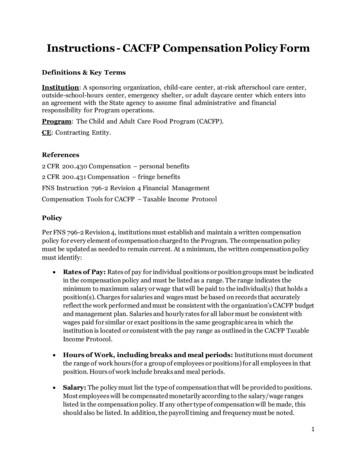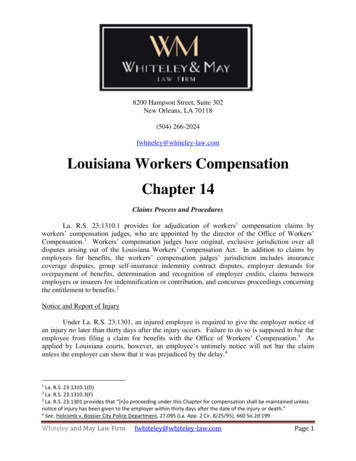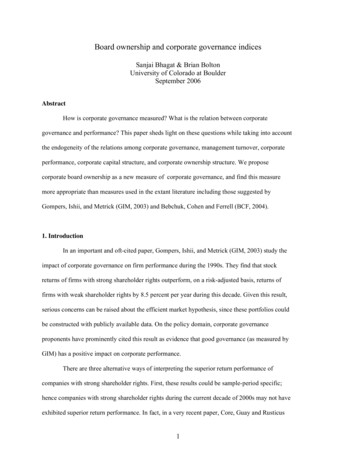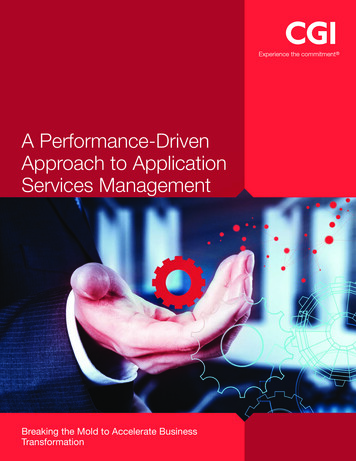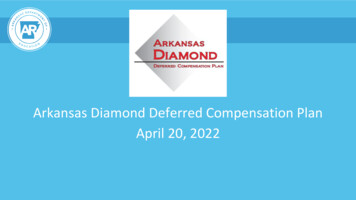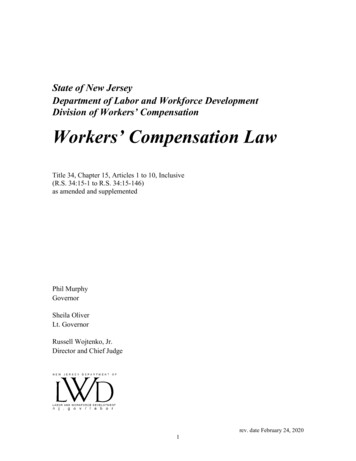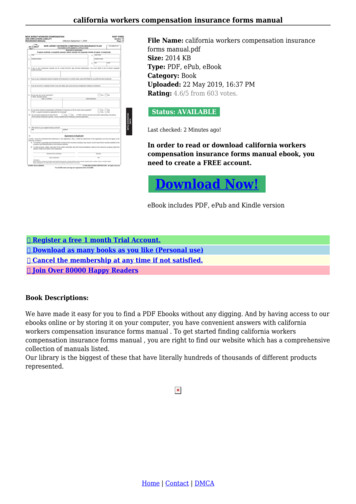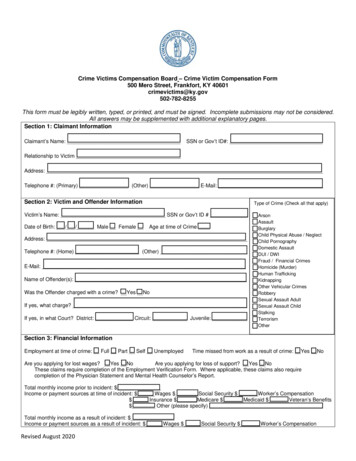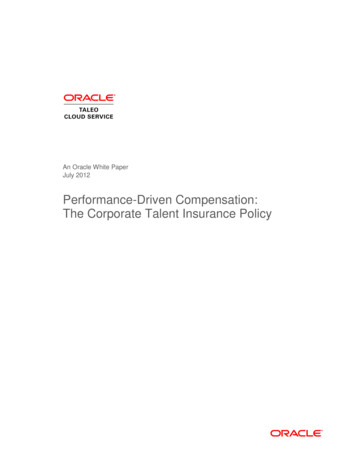
Transcription
An Oracle White PaperJuly 2012Performance-Driven Compensation:The Corporate Talent Insurance Policy
Performance-Driven Compensation: The Corporate Talent Insurance PolicyIntroduction . 1Compensation as a Talent Insurance Policy . 2Pay for Performance. 2Top Performers and High Potentials . 4The Advantages and Complexities of Differentiated Compensation. 7Building Differentiated Compensation: Five Steps . 9Step 1: Strategy . 10Step 2: Technology Support . 11Step 3: Tactics and Programs. 13Step 4: Measurement . 13Step 5: Communication . 14Pay for Potential . 15Differentiated Compensation in Action: A Case Study . 16Conclusion . 16
Performance-Driven Compensation: The Corporate Talent Insurance PolicyIntroductionAn average company’s biggest expense—and biggest differentiator—is its talent. As much as170 percent of business expense is on people: hiring, salary, and benefits. Yet in the U.S.alone, the average churn of staff is a staggering 40 percent. More alarming: in 2009, half ofthat churn was voluntary—people deciding to leave their jobs to find something better.2As economic conditions improve and businesses worldwide look to regroup and even reinventthemselves, smart talent management has never been more crucial. Central to that strategy ismanaging risk through talent insurance policies that more accurately find and incent the bestperformers with differentiated compensation. More than 80 percent of companies around theworld are offering variable-pay programs or performance-based awards that must be re-earnedeach year.3This white paper explores the genesis of differentiated compensation and outlines how tocreate strategy, process, and supporting technology infrastructure to move from “good enough”compensation management to a program that aligns employee compensation to a company’skey business goals.Bersin & Associates, “Enterprise Compensation Solutions: The Next Wave in Integrated TalentManagement,” 2009.2 United States Bureau of Labor Statistics.3 Hewitt, “Global Compensation Survey,” 2010.11
Performance-Driven Compensation: The Corporate Talent Insurance PolicyCompensation as a Talent Insurance PolicyWhy do companies need insurance? Insurance provides a means to mitigate the negative impact offoreseen and unforeseen events on the business. The job of corporate risk managers is to eliminatevisible hazards that could increase the probability of damaging events.Executives are themselves risk managers when it comes to their most valuable assets: their talent.McKinsey & Company’s groundbreaking research 4 in 1997 on competition for talent implied that topperformers and high-potential employees were scarce and needed to be treated as precious resources.Today, despite high global unemployment, this concept is no less true.As has been the case for decades, top talent always has employment options and rarely has to activelyseek out good opportunities. Surprisingly, according to the U.S. Bureau of Labor Statistics, voluntaryturnover rates were about 20 percent in the United States in 2009. This was in the face of an economicdownturn that contributed to an unemployment rate of more than 10 percent of the population.So, how do executives create the talent insurance needed to mitigate the risk of losing their top talent?One pivotal strategy—recently enabled with technology—is to tightly link employee and businessperformance to compensation and other rewards.Pay for PerformanceThe idea of paying employees for their impact on the business can be traced back to ancient times. Payfor performance is an admirable goal for managers, yet businesses have struggled with implementingthese practices.Figure 1. Highly differentiated compensation is an admirable goal but can be difficult for managers to execute.4McKinsey & Company, Organization and Leadership Practice, “The War for Talent”, April 2001.2
Performance-Driven Compensation: The Corporate Talent Insurance PolicyCultural barriers play a significant role in this struggle. Pay for performance requires managers toclearly articulate expectations for employees and then have frank, honest dialogue with theseemployees about accomplishments, shortfalls, and competency gaps.These conversations require management skill. Yet many managers lack the training needed toeffectively assess performance and provide coaching and feedback. Regardless of management training,there is a further complication in consistent application or performance calibration of assessmentsbetween managers within departments, divisions, and across the company.The result of being unable to objectively create and align goals and differentiate employee performanceagainst these goals is often a contributor to a “peanut-butter” approach to compensation. Thisapproach—while well intentioned to be fair to all staff—takes available merit and bonus budgets andspreads them somewhat uniformly across the entire employee base. The outcome is anything but fair—to the key performers or to the business itself. Diluting the impact of the bonus pool in turn dilutes theperceived value of the incentive.Evenly spread compensation definitely alleviates the short-term pain of having to hold difficultconversations with employees or attempting to ensure assessment calibration across all reviews in anorganization. However, the long-term effect is that top performers lose motivation in their work asthey see their results rewarded in much the same way as lower-performing coworkers. The unfortunateconsequence: a company increases its risk of losing the very people who are giving it a competitiveedge in the market. Top performers will look for companies that recognize and reward highproductivity with disproportionately weighted compensation models.Another key barrier in achieving a true pay-for-performance model is the lack of automation tools thathave been available. These methods make it extremely difficult to have a single view of performanceand compensation data linked together, provide performance calibration, and ensure the right peopleare aligned with the right compensation and incentive options.Today, this alignment is often done manually. The vast majority of performance and talentmanagement software systems (more than 90 percent by our estimates) are not integrated with acompensation system. This means the company completes its annual performance managementprocess, prints out the results, and then re-enters those results (or lets managers enter them) into theircompensation changes. Such an approach is error-prone and time-consuming, and makes a “totalrewards” strategy difficult to implement. 5Bersin & Associates, “Enterprise Compensation Solutions: The Next Wave in Integrated TalentManagement,” 2009.53
Performance-Driven Compensation: The Corporate Talent Insurance PolicyOut of six key priorities provided to respondents, organizations identified employee engagement and talent management as themost significant to professionals (almost 70 percent each). 69 percent of organizations said they were concerned about theretention of high performers and 63 percent of organizations use salary increases as a mechanism for rewarding their highperformers. Schemes for recognition, talent management, and career development are used by 39 percent, 41 percent, and 47percent, respectively. Encouragingly, only 9 percent are not using any form of reward mechanism for their high performers. 6Notably, just 19 percent of respondents to a Taleo Research 7 study in the U.K. stated that theiremployer calculates bonuses using personal performance targets linked to business goals. 8 Without thetalent management skills or the companywide view of talent, companies are increasing their risks withthe vast majority of their costs. The more strategic the talent is to the business operation, the greaterthe exposure.Top Performers and High PotentialsCEOs and senior executives are aware of the criticality of hiring, engaging, and retaining highperformers for their organizations: 97 percent of CEOs in a global survey responded that access to,and retention of, key talent is their #1 source of competitive advantage in sustaining growth over thelong-term. 9What defines a top performer or a high-potential employee? Talent management analyst firm Bersin &Associates defines the difference as follows:A high performer is an employee who: Is a key contributor Demonstrates high performance Is capable of a lateral move May be qualified for a broader role within the same profession Has reached the potential to move upward in a management capacityBy comparison, a high-potential employee (often referred to as “HiPo”) is a high performer who hasalso been identified as having the potential, ability, and aspiration for successive leadership positionswithin the company, typically two levels or more. 10Hay Group U.K., “Reward in 2010 Research.”Oracle acquired Taleo in June 2012.8 Taleo Research, “The Bonus Barometer,” 2009.9 Pricewaterhouse Coopers, “12th Annual Global CEO Survey,” 2009.10 Bersin & Associates, “High Potential Versus High Performance: What Is the Real Difference?” 2008.674
Performance-Driven Compensation: The Corporate Talent Insurance PolicyThe “War for Talent” study crystallized the impact of quality performers. 11 It found that in the opinionof senior managers, high performers outperform average performers by a wide margin. According tothe study, high performers in operations roles are able to increase productivity by 40 percent, highperformers in management roles increase profits by 49 percent, and in sales positions high performersare responsible for 67 percent greater revenue.Figure 2. Good people are great for business. 12Given the enormous difference in productivity between average and top performers, it seems thatcommon sense would dictate weighting a large share of available compensation budgets to theseresources. Yet executive coach and author Dr. Marshall Goldsmith asked more than 2,000 corporatemanagers about the difference in pay between a top performer and a below-average performer of thesame grade. The answer: a surprisingly low 5 percent to 10 percent difference in pay, while these samemanagers indicated that the difference in contribution to the business from these performers was morethan 100 percent. 13The unpredictability of what businesses have experienced since the 2009 recession makescompensation planners acutely aware of the need to keep costs under control while balancing the needto attract, motivate, and retain workers with the right talent and skills to ensure business success. 14McKinsey & Company, “The War for Talent,” 2000.McKinsey & Company, “The War for Talent,” 2000. (A survey of 410 corporate officers at 35 large U.S.companies.)13 Dr. Marshall Goldsmith, “Retain Your Top Performers,” 2008.14 The Conference Board of Canada, “Modest Increase in Pay Expected for Canadian Workers in 2010.”11125
Performance-Driven Compensation: The Corporate Talent Insurance PolicyFigure 3. A variety of measures were taken by companies to control compensation costs during the recession.15While there are a multitude of tactics that can be used to retain top performers and high-potentialemployees, compensation is a way to mitigate risk and lower hiring costs.However, when top talent decides to leave a company, there is significant cost in addition to the loss ofproductivity. Multiple research studies have shown that the cost of replacing an employee can be ashigh as three times their annual salary. This double whammy of decreased productivity and increasedhiring makes it easy to see why executives are focused on retaining critical talent.Costs of Turnover: Productivity loss Legal liability Loss of customers Separation costs Loss of brand equity Replacement costs Loss of intellectual propertyFinally, retaining critical talent has impact beyond increased productivity. As companies create plans togrow by looking for new markets and introducing new products, their leadership pipelines and thebench strength of employees for critical positions takes on new importance. Making sure the highpotential employees that make up this talent pipeline are engaged and rewarded appropriately is aconstant challenge for executives.These statistics highlight the significant business lever that executives have—but don’t alwaysoptimize—in the quest to create high-performance cultures. The challenge is marrying top businessgoals to strategic execution.15“Reward Lessons from the Crisis,” Hewitt Quarterly Asia Pacific, Volume 7/Issue 1.6
Performance-Driven Compensation: The Corporate Talent Insurance PolicyThe Advantages and Complexities of Differentiated CompensationToday’s compensation and talent management professionals are looking strategically at the role ofperformance-driven rewards as a key lever for engaging and retaining top performers. There arenumerous strategies for creating a high-performance culture, and today’s technology advances havecreated major opportunities for looking at performance assessment and compensation structuresdifferently than in the past.Historically, companies had fairly narrow boundaries for compensation plans. The major levers werethe merit increase for base pay and bonuses for achievement of goals. While these are still primary,compensation departments are looking more broadly at other variable pay mechanisms that take intoaccount business performance in addition to employee performance.The most basic example of this type of reward mechanism is to tie a portion of an employee’scompensation to the company’s financial performance measures, such as sales or revenue at company,division, or even departmental levels. This is an easily available metric that all employees understand.The issue is that the linkage of employee work to this particular measure might not be clear-cut.TABLE 1. COMPENSATION COMPONENTS TO BE REDESIGNED OVER THE NEXT 12 MONTHSANSWER16:PERCENTAGE OF RESPONDENTSVariable pay64%Base pay42%Sales compensation plans37%Equity30%Nonqualified deferred compensation plan14%Employee stock purchase plans8%To circle back to the notion of risk management and insurance, variable reward programs can bethought of as profit insurance. When a company has lower than expected profits, variablecompensation budgets are reduced to mitigate any shareholder impact. This is not punitive, as theshareholders have based their investment on the performance of the company and employee actionsare directly linked to this performance. On the flip side of the coin, when the company’s profits exceed16Thomsons Online Benefits, “Asia Pacific Employee Rewards Watch,” 2008.7
Performance-Driven Compensation: The Corporate Talent Insurance Policytargets, the bonus pool is deepened and employees reap the benefits of the linkage between theirperformance and the exceptional results.One U.K. study found that top reward priorities were ensuring that the reward was aligned with thebusiness strategy (52 percent) and ensuring that reward packages were market competitive (51 percent).While cost minimization was still one of the key priorities, it had slipped to being as equal a priority asensuring the reward is internally fair (44 percent). 17Other business success metrics being linked to employee compensation include customer satisfaction,customer retention, and customer support. These get a bit trickier to map to individual levels, yet theyare critical to a company’s success.Savvy businesses are also looking at other incentives to retain top performers. Grants of stock optionsand full value shares, education and other development activities, and spot bonuses are also beingfactored into differentiated compensation plans. Interestingly, top talent rarely leaves a company forcompensation reasons alone.Figure 4. Top talent rarely leaves a company for compensation reasons alone.18Multiple studies cite that a lack of employee development activities is a key decision point for topperformers. Therefore, using development activities—whether they are educational opportunities,formal mentor relationships, or stretch assignments—as rewards for top performance is cost-effectiveand helps enhance retention. This is potentially powerful insurance for key players in the organization.But for compensation professionals, it is increasingly complex to design, administer, and keep current.1718Chartered Institute of Personnel and Development (CIPD), “2010 Reward Survey.”“Connecting the Dots,” Hewitt Quarterly Asia Pacific, Volume 7/Issue 1.8
Performance-Driven Compensation: The Corporate Talent Insurance Policy19Elements of Employment Deals Expected to Change :In Mercer’s 2010 study, “Human Capital Planning,” most respondents were very (21 percent) or somewhat (75 percent) confidentthat their current employment deals would attract the future workforce they need to meet business requirements. However, morethan 4 in 10 indicated that their future employment deals would include a greater emphasis on career development (47 percent),incentive compensation (42 percent), and leadership connection with the workforce (41 percent).The more tightly aligned the high-performance culture, the more complex the compensation scenarios.Compensation professionals must look at multiple types of measures for various roles in the company.This is further complicated when factoring in commensurate incentives across geographic andregulatory boundaries.This complexity makes it hard—if not impossible—to keep up with all the potential incentive andregulatory parameters with manual processes and spreadsheets. In large organizations, the process is socomplex it is common to find “leakage” in compensation. For example, by the time some businessesget their compensation budgets approved, the compensation pools do not reflect the reality of the staffcurrently in place.This can result in: Allocating limited compensation budgets to employees who leave shortly after the compensationcycle is complete Managers “gaming” the system to keep their compensation budgets the same even after they havelost staff Human error in data entry and calculations in spreadsheets Unnecessary waste of resourcesBuilding Differentiated Compensation: Five StepsCreating a strong differentiated compensation program includes five major steps:1) Strategy2) Technology Support3) Tactics and Programs4) Measurement5) Communication19Mercer, “Human Capital Planning,” 2010.9
Performance-Driven Compensation: The Corporate Talent Insurance PolicyStep 1: StrategyIt might seem to be common sense, but many talent management and compensation initiatives fail toachieve the desired results because implementation starts without a clear sense of the objectives andthe success criteria for the project.A compensation strategy maps the desired company results with the necessary behaviors needed fromemployees across the company. Once the behaviors are determined, the best combination of rewards isselected to achieve these behaviors. Since the company wants to encourage employees to perform at anextremely high level, the compensation strategy ties to the company’s overall talent management andperformance assessment strategy.If the company strategy is to focus a higher proportion of the compensation budget on top performersand high-potential employees, it is critical to be able to identify this category of employee. This iswhere many companies encounter substantial barriers. When the performance assessment strategyclearly defines the criteria for high performance, managers and employees have a solid foundation for aclear, consistent, and frequent dialogue about the employee’s progress.Best-in-class performance management will usually have the following attributes: Goals that are aligned throughout the organization. The goals should be SMART (Specific,Measurable, Attainable, Relevant, and Timely) to ensure that employees know exactly what isexpected. Continuous feedback and dialogue between manager and employee to assess progress against thosegoals. Regular (typically annual or biannual) focal performance reviews that assess the “what” (what did theemployee achieve when measured against goals?) and “how” (how did the employee achieve thegoals measured against the organization’s values and desired competencies?). A talent calibration and talent review process across the entire organization that adjusts for variationsin how managers assess performance and brings out potentially hidden high potentials and topperformers.If these pieces are not in place, companies might be managing the performance process by gut feel.This results in a lack of checks and balances and becomes a popularity contest for top talent. This ishow “diamonds in the rough” in an otherwise poorly performing team or group might go unnoticed,or underperformers might hide in the glow of superstar colleagues.The SMART goals portion of the strategy ideally should include the company and employee metricsthat are being targeted. Relevant company metrics, for example, might include: Revenue Sales Customer Service Quality Statistics10
Performance-Driven Compensation: The Corporate Talent Insurance PolicyThese metrics can apply to the entire company, specific departments or business units, differentgeographies, or any other relevant segment of employees. For example, American companies typicallyhave global compensation and benefits strategies (100 percent of American companies as opposed to63 percent of French companies). 20It is obvious that the number of combinations can easily overwhelm the strategy team, so ensuringonly the most crucial measurement categories are used goes a long way in making sure that the planswill actually be implemented.The strategy phase will cover the timing of the performance assessment and compensationmanagement cycles during the year as well as the mix of cash versus noncash incentives. These aretypically decisions made very infrequently and represent the company’s general talent management andfiscal philosophies.Another critical decision is how the compensation philosophy reflects the company values. If acompany values a performance-driven culture, the retention of top performers is critical. As a result,the compensation philosophy might be to compensate the role at a higher position compared to themarket. This will drive the downstream programs and tactics employed by the compensation team.Step 2: Technology SupportThe entire performance and compensation process should have a strong technology underpinning.Without a strong talent technology platform, companies end up with static goals and performancedocuments that are not modified based on changing business conditions and are not reviewed until thenext performance cycle.In addition, the talent calibration process relies on a single view of organization talent. Without atechnology enabler, talent reviews become a lengthy and costly manual process. The technology is alsocritical to move the calibrated performance assessment data into the compensation technology process.Given the extraordinary complexity of global compensation plans, flexible and highly configurabletechnology is essential to manage the process in a way that enables focus on top performers. Thetechnology should take the “heavy lifting” off of the compensation team with regards to compensationrule definition and editing, employee eligibility, and transparency into process and practice in anyorganization across the globe.Considerations for the technology platform should include a review of how compensation rules andcalculations are created, edited, and implemented. This will be absolutely critical in order to administera complex compensation landscape. Additionally, the system should be capable of dynamicallycalculating employee eligibility. Since employees might be eligible for multiple plans—and it is certainORC Worldwide, “The Growing Impact of Equality and Diversity in Compensation and Benefits,”September 2008.2011
Performance-Driven Compensation: The Corporate Talent Insurance Policythat employees will transfer between departments and geographies—eligibility can change along withthese transitions.To use metrics from the finance and customer support systems, consideration should be given towhether the compensation system can use the input system to calculate variable pay. For example, ifemployees are compensated based on financial results for their division, the compensation engine mustcalculate the proper compensation based on the data passed from the finance system.Figure 5. Effective compensation management technology should be designed to handle the increasing level ofcomplexity of all the different existing and emerging compensation plans and tools.Finally, the company might consider whether the system can accommodate a single consolidated viewof compensation budgets. This is a radical departure from the manual spreadsheet-driven process thatrequires the compensation team to compile multiple disparate spreadsheets. As employees transferwithin the organization, leave the company, or get hired, manual processes make it difficult to reactand change the budgets accordingly. Because the budgets are a challenge to keep updated, there is ahigh likelihood of budget leakage, where monies are not controlled tightly and are then not available touse on the top talent.Many existing systems are limited in that they require companies to standardize their compensationplans, which forces the plans to conform to existing rules. An effective compensation managementtechnology should be designed to handle the increasing level of complexity of all the different existingand emerging compensation plans (variable pay and pay for performance) and tools (such as options,restricted stock units, phantom stock, and short- and long-term incentive plans).Key Features of Compensation Planning Systems Global compensation rules library Configurable total compensation platform Global total compensation budget dashboard Integration with performance, goals, and other systems Base salary and merit planning Incentives and bonus planning Equity, stock, and long-term incentive (LTI) planning Total rewards statements12
Performance-Driven Compensation: The Corporate Talent Insurance PolicyStep 3: Tactics and ProgramsThe next phase of implementing highly differentiated compensation is setting the tactics and programsessential to execute on the strategy. These tactics include making the following decisions: Who should be eligible for a bonus or other variable compensation program? How are the pivotal roles that influence the company metrics identified and at what percentage ofthe market pay range are they paid? How does the company ensure that an employee’s total compensation including variable plans andequity stays within the market ranges for the role? What are actual quantitative targets for the performance metrics? What percentage of the compensation plans is based on company versus business unit versusindividual performance? What percentage of the company’s compensation budget will be set aside for top performers? What is the framework for the employee communications strategy? What percentage of available equity pool is allocated to top performers and high-potentialemployees?The tactics and programs step is essential for performance and compensation conversations to occur.Objective performance discussions between managers and employees are only possible if specificcriteria are set. The other outcome of this step is that macrolevel communication can occur to alert theorganization as to the incentive targets possible if high performance is achieved.Step 4: MeasurementThe next step for developing a differentiated compensation program is to measure progress for thebusiness and for the individual. As discussed above, a high-performance culture is created byestablishing an environment where consistent and frequent discussions about employee performanceare held between manager and employee. These discussions help employees correct any performancegaps early enough in the cycle to make sure they can attain the targets for high performance.Talent analytics and reporting that provide enterprisewide, reliable data is the key to program successand continuous improvement, yet too often lacking. Although 93 percent of respondents to a TaleoResearch survey of U.S. human resources (HR) and line-of-business executives consider it important toknow the compensation benchmarks by job classification and the distribution of performance ratings13
Performance-Driven Compensation: The Corporate Talent Insurance Policyversus compensation, only 55 percent and 51 percent respectively have access to reliable data to informthem. 21The other critical measurement is business performance. Frequent updates from the business unitsregarding progress against the stated goals help employees understand whether their performance is“moving the needle” on the right metrics.Step 5: CommunicationCommunicating to employees the results of the year’s progress against goals—both individual andbusiness—is the final step in creating the differentiated compensation program. Total rewardsstatements are a useful tool in this process. Top performers will clear
The more strategic the talent is to the business operation, the greater . to attract, motivate, and retain workers with the right talent and skills to ensure business success. 14: 11 McKinsey & Company, "The War for Talent," 2000. . Today's compensation and talent management professionals are looking strategically at the role of



